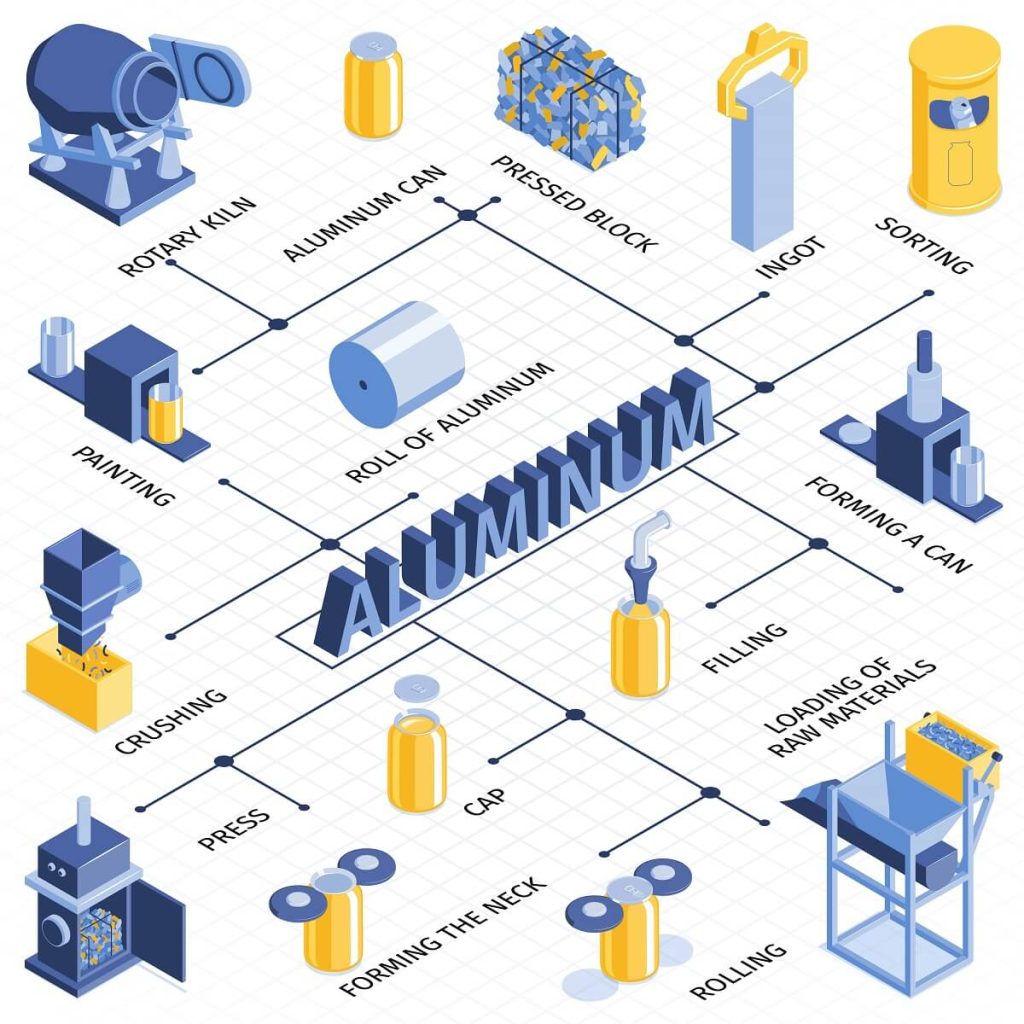Aluminum is a versatile and lightweight material that is widely used in various industries, such as automotive, construction, and aerospace. One of the primary ways to manufacture aluminum products is through the extrusion process. This process involves the use of specialized equipment and techniques to create aluminum parts with a wide range of shapes and sizes. In this article, we will take a closer look at the aluminum extrusion process and its step-by-step procedure.
In this article, we will discuss:
- Introduction
- The Extrusion Process
- Raw Material Preparation
- Billet Heating
- Extrusion Process Steps
- Die Design and Selection
- Extrusion Press and Tooling
- Extrusion Speed and Temperature
- Cooling and Quenching
- Cutting and Finishing
- Post-Extrusion Treatments
- Quality Control
- Applications of Extruded Aluminum
- Advantages of the Extrusion Process
- Conclusion
- FAQs
Introduction
Aluminum extrusion is a manufacturing process that involves the shaping of aluminum into a wide range of profiles, such as tubes, angles, channels, and bars. This process has become increasingly popular due to its flexibility, cost-effectiveness, and eco-friendliness. Extruded aluminum products are used in various applications, such as window frames, door frames, curtain walls, heat sinks, and automotive parts.
The Extrusion Process
The aluminum extrusion process involves the use of specialized equipment and techniques to shape aluminum into various profiles. The process consists of several steps, including raw material preparation, billet heating, extrusion process steps, die design and selection, extrusion press and tooling, extrusion speed and temperature, cooling and quenching, cutting and finishing, post-extrusion treatments, and quality control.
Raw Material Preparation
The first step in the extrusion process is to prepare the raw material, which is usually in the form of a cylindrical billet. The billet is typically made from aluminum alloys, which are carefully selected based on the desired properties of the final product. The billets are cleaned, inspected, and sawed to the required length for the extrusion process.
Billet Heating
The next step is to heat the billet to the appropriate temperature for extrusion. The heating process is essential to make the aluminum soft enough to shape but not too soft that it will deform during the process. The temperature and duration of the heating process depend on the type of alloy and the size of the billet.
Extrusion Process Steps
Once the billet reaches the desired temperature, it is loaded into the extrusion press. The press consists of a chamber, a ram, and a die. The chamber holds the billet, and the ram applies pressure to push the billet through the die, which shapes the aluminum into the desired profile.
Die Design and Selection
The die is a critical component of the extrusion process, as it determines the shape and dimensions of the final product. The die is made from a high-strength material, such as tool steel, and is designed to withstand the high temperatures and pressures of the extrusion process. The die is selected based on the specifications of the final product and is custom-made for each order.
Extrusion Press and Tooling
The extrusion press is the heart of the extrusion process, as it provides the force required to push the aluminum through the die. The press consists of a hydraulic system that generates the pressure needed to move the ram and push the billet through the die. The press also has various tooling components, such as clamps, shear blades, and dummy blocks, that help shape the aluminum and maintain the integrity of the extruded product.
Extrusion Speed and Temperature
The extrusion speed and temperature are critical factors that affect the quality and properties of the final product. The speed of the press determines the rate at which the aluminum flows through the die, and it is adjusted based on the shape and dimensions of the profile. The temperature of the aluminum is closely monitored to ensure that it remains within the ideal range during the extrusion process.
Cooling and Quenching
After the aluminum is extruded, it is cooled and quenched to prevent it from deforming or warping. The cooling process involves using water or air to reduce the temperature of the extruded profile. The quenching process involves rapidly cooling the aluminum to further harden and strengthen it. The cooling and quenching process must be carefully controlled to prevent cracking or other defects in the extruded product.
Once the aluminum has been extruded through the die, it is rapidly cooled and quenched to prevent it from deforming or warping. The cooling process can be achieved through various methods, such as water quenching, air cooling, or artificial aging. The cooling rate and method depend on the alloy and the desired properties of the final product.
Cutting and Finishing
Once the extruded aluminum is cooled and quenched, it is cut to the desired length and finished as needed. The cutting process is typically done using a saw or other cutting tool. The finished product may also undergo additional processing, such as surface treatment or machining, to improve its appearance and functionality.
After the extrusion process is complete, the aluminum is cut to the required length and finished to the desired shape and surface finish. The cutting process can be achieved through various methods, such as sawing, shearing, or punching. The finishing process can include deburring, polishing, anodizing, or powder coating, depending on the application and requirements of the product.
Post-Extrusion Treatments
Post-extrusion treatments may also be applied to the aluminum product to further enhance its properties. These treatments may include annealing, aging, or heat treatment, depending on the type of alloy and the intended application. These treatments can improve the strength, durability, and corrosion resistance of the aluminum product.
Some extruded aluminum products may require additional treatments after the extrusion process to enhance their properties or performance. These treatments can include heat treatment, stretching, bending, or welding. These treatments can improve the strength, durability, or corrosion resistance of the extruded product.
Quality Control
Throughout the extrusion process, quality control measures are implemented to ensure that the final product meets the required specifications. These measures may include visual inspections, dimensional measurements, and material testing. Any defects or deviations from the required specifications are identified and addressed before the product is shipped to the customer.
Quality control is an essential aspect of the aluminum extrusion process, as it ensures that the final product meets the required specifications and standards. Quality control measures can include visual inspection, dimensional measurement, mechanical testing, and chemical analysis. These measures help identify any defects or deviations in the extruded product and ensure that it is of the highest quality.
Applications of Extruded Aluminum
Extruded aluminum products have a wide range of applications in various industries. Some common applications include window frames, door frames, curtain walls, heat sinks, and automotive parts. Extruded aluminum is also used in the construction of aircraft and other transportation vehicles, as well as in the manufacturing of consumer electronics and appliances.
Extruded aluminum products have a wide range of applications across various industries. These products are used in construction, transportation, electronics, and other fields. Some common applications of extruded aluminum products include window frames, door frames, curtain walls, heat sinks, automotive parts, and structural components.
Advantages of the Extrusion Process
The extrusion process offers several advantages over other manufacturing processes. These include:
- Flexibility: The extrusion process can produce a wide range of shapes and sizes, allowing for greater design flexibility.
- Cost-effectiveness: Extruded aluminum products are cost-effective compared to other manufacturing processes, as they require fewer resources and materials.
- Eco-friendliness: The extrusion process is eco-friendly, as it generates minimal waste and can use recycled materials.
The aluminum extrusion process offers several advantages over other manufacturing processes. It is a cost-effective and eco-friendly process that produces high-quality products with excellent dimensional accuracy and surface finish. It also offers a wide range of design possibilities, as the aluminum can be shaped into various profiles and sizes.
Conclusion
The aluminum extrusion process is a versatile and efficient manufacturing process that offers several benefits over other manufacturing processes. The process involves several steps, including raw material preparation, billet heating, extrusion process steps, die design and selection, extrusion press and tooling, extrusion speed and temperature, cooling and quenching, cutting and finishing, post-extrusion treatments, and quality control. Extruded aluminum products have a wide range of applications across various industries and offer several advantages, such as cost-effectiveness, eco-friendliness, and design flexibility.
FAQs
- What is extruded aluminum?
Extruded aluminum is a process of manufacturing aluminum products by shaping them into various profiles, such as tubes, angles, channels, and bars.
- What are the applications of extruded aluminum products?
Extruded aluminum products have a wide range of applications in construction, transportation, electronics, and other fields. Some common applications include window frames, door frames, curtain walls, heat sinks, automotive parts, and structural components.
- What are the advantages of the aluminum extrusion process?
The aluminum extrusion process offers several advantages over other manufacturing processes. It is a cost-effective and eco-friendly process that produces high-quality products with excellent dimensional accuracy and surface.
- What factors affect the quality of the extruded product?
The extrusion speed, temperature, and die design all play a critical role in the quality of the extruded product. These parameters must be carefully monitored and controlled to ensure that the aluminum flows evenly through the die without any defects or deformations.
- What post-extrusion treatments may be required for extruded aluminum products?
Some extruded aluminum products may require additional treatments after the extrusion process to enhance their properties or performance. These treatments can include heat treatment, stretching, bending, or welding. These treatments can improve the strength, durability, or corrosion resistance of the extruded product.
Image by macrovector on Freepik

